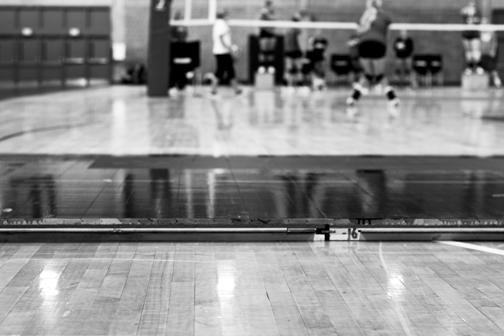If you head over to the court at the Clark Athletic center, you may notice something odd. There is a new, raised floor surrounded by metal ramps in the center of the gym. This is a temporary fix for a problem that has plagued UMB athletes for years, and the basketball as well as volleyball teams are thrilled to finally have some relief. The floor at the Clark Center is as old as the campus itself, and it also lacks the give that is standard across the NCAA. According to athletic trainer Ed Anderson, “a typical basketball floor has about 45-50% give. The problem with the old floor is that it had no give in it. The [temporary] new floor that is down now has a lot more cushion in it.” The lack of give in the old floor led to plenty of injuries over the last few years for not only the squads, but the multitude of students that play pick up basketball on the court every day.
The new parquet is a thing of beauty. It looks like it was just cut last week, and doesn’t have a thick layer of wax built up on it over time. But looks can be deceiving, and for some athletes the change hasn’t been instant. Volleyball captain Frana Burtness-Adams said “we’re not sure if it’s better yet. It looks better and feels better, if the amount of injuries decrease then we will all be happy”. Anderson has already noticed a decrease in injuries. He said “we’ve definitely seen a reduction of use type injuries so far.” The use of the floor isn’t at it’s maximum yet. According to Anderson, “starting October 15th (when basketball officially starts up) the floor will be seeing 6-8 hours of use every day”.
On the old floor, the injuries suffered were usually the type that lingered on for a while, such as shin splints (tiny fractures that develop in the shin from repeated abuse). Sophomore Colleen Hooper had difficulties with the ailment her rookie year. She said “playing on the court last year caused me to have shin splints. I haven’t had any issues since the new floor has been put in, and its appearance has greatly improved.” Although Advil usually makes them tolerable, the injuries can have a pronounced effect on performance. It’ll be interesting to see if scoring and team speed improve on this fresh surface. The question is: why now? Well there really isn’t a great answer. The athletic department most likely noticed that it was simply too dangerous to let the student athletes continue to play on the surface and they needed a fix. Anderson said “the old floor was in pretty rough shape and kids were missing games in high amounts because of it, administration took notice”. Athletic Director Charlie Titus said that there would be a new permanent floor put in after basketball season.
In the meantime this floor is a huge improvement from what was already there, although there are some drawbacks. Athletes are most likely going to get injured while chasing balls out of bounds because of the sharp decline down to the old floor. A basketball player said “even with the ramp it’s easy to stumble off the side if you’re running out of bounds, I’m concerned about getting hurt.” Regardless there will be a more permanent solution to the problem next year but it already seems like the temporary parquet has helped. Hopefully this modern upgrade will help the Beacons both on the court and in the doctor’s office, and it should be reflected in their results this year.





















































